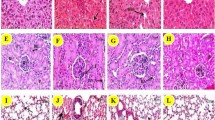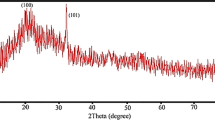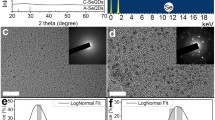Abstract
Selenium (Se), a potential drug candidate for cancer prevention, has a special property: Its nutritional dosage and tolerable upper intake level appear in a narrow range, while the therapeutic use of this mineral may depend on a higher body intake level. Nano-selenium (nano-Se) particles, however, preserve the selenium element’s low toxicity characteristic but give a high biochemical activity effect of selenium compounds. In the present study different morphologies of synthesized nano-Se were evaluated concerning its anti-proliferation and apoptosis-inducing effect. Then nano-Se (sphere) were picked out to investigate its influence on two significant events involved in apoptosis, cell cycle arrest and mitochondrial membrane potential disruption. Furthermore, massive vacuolization of HeLa cells treated by nano-Se (sphere) was observed and more methods were used to measure the level of vacuolization. Such vacuolization needs energy supply and has been demonstrated to be related to Se endocytosis. These results suggest a possible mechanism to trigger apoptosis initiation.
Similar content being viewed by others
References
Schwarz K, Folz CM. Selenium as an integral part of factor 3 against dietary necrotic liver degeneration. Nutrition, 1957, 15: 255–264
Beguin Y, Bours V, Delbrouck JM, Robaye G, Roelandts I, Bury J, Fillet G, Weber G. Relationship of serum selenium levels to tumor activity in acute non -lymphocytic leukemia. Carcinogenesis, 1989, 11: 2089–2091
Clark LC, Combs GF, Turnbull BW, Slate EH, Chalker DK, Chow J, Davis LS, Clover RA, Graham GF, Gross EG, Krongrad A, Lesher JL, Park HK, Sanders BB, Smith CL, Taylor JR. Effects of selenium supplementation for cancer prevention in patients with carcinoma of the skin. J Am Med Assoc, 1996, 276: 1957–1963
Ip C, White G. Mammary cancer chemoprevention by inorganic and organic selenium: Single agent treatment or in combination with vitamin E and their effects on in vitro immune functions. Carcinogenesis, 1987, 8: 1763–1766
Cho DY, Jung U, Chung AS. Induction of apoptosis by selenite and selenodiglutathione in HL-60 cells: Correlation with cytotoxicity. Biochem Mol Biol Int, 1999, 47: 781–793
Ip C, Thompson HJ, Zhu Z, Ganther HE. In vitro and in vivo studies of methylseleninic acid: Evidence that a monomethylated selenium metabolite is critical for cancer chemoprevention. Cancer Res, 2000, 60: 2882–2886
Menter DG, Sabichi AL, Lippman SM. Selenium effects on prostate cell growth, cancer Epidemiology. Biomarkers Prev, 2000, 9: 1171–1182
Ghosh J. Rapid induction of apoptosis in prostate cancer cells by selenium: reversal by metabolites of arachidonate 5-lipoxygenase. Biochem Biophy Res Commun, 2004, 315: 624–635
Wang H, Zhang J, Yu H. Elemental selenium at nano size possesses lower toxicity without compromising the fundamental effect on selenoenzymes: Comparison with selenomethionine in mice. Free Radical Biol Med, 2007, 42: 1524–1533
Zhang J, Wang H, Yan X, Zhang L. Comparison of short-term toxicity between Nano-Se and selenite in mice. Life Sci, 2005, 76: 1099–1109
Zhang J, Wang X, Xu T. Elemental selenium at nano size (nano-Se) as a potential chemopreventive agent with reduced risk of selenium toxicity: Comparison with Se-methylselenocysteine in mice. Toxicol Sci, 2008, 101(1): 22–31
Zhang JS, Gao XY, Zhang LD, Bao YP. Biological effects of a nano red elemental selenium. Biofactors, 2001, 15: 27–38
Wyllie AH, Kerr JF, Currie AR. Cell death: the significance of apoptosis. Int Rev Cytol, 1980, 68: 251–306
Harris CC. p53 tumor suppressor gene: from the basic research laboratory to the clinic-an abridged historical perspective. Carcinogenesis, 1996, 17: 1187–1198
Cantley LC, Neel BG. New insights into tumor suppression: PTEN suppresses tumor formation by restraining the phosphoinositide 3-kinase/AKT pathway. Proc Natl Acad Sci, 1999, 96: 4240–4245
Downward J. Mechanisms and consequences of activation of protein kinase B/Akt. Curr Opin Cell Biol, 1998, 10: 262–267
Evan G, Littlewood T. A matter of life and cell death. Science, 1998, 281: 1317–1322
Solary E, Bertrand R, Pommier Y. Apoptosis induced by DNA topoisomerase I and II inhibitors in human leukemic HL-60 cells. Leuk Lymphoma, 1994, 15(1–2): 21–32
Ghose A, Fleming J, El-Bayoumy K, Harrison PR. Enhanced sensitivity of human oral carcinomas to induction of apoptosis by selenium compounds. Cancer Res, 2001, 61: 7479–7487
Ganther HE. Pathways of selenium metabolism including respiratory excretory products. J Am Coll Toxicol, 1986, 5: 1–5
Zhang B, Dai W, Ye XC, Zuo F, Xie Y. Photothermally assisted solution-phase synthesis of microscale tubes, rods, shuttles, and an urchin-like assembly of single-crystalline trigonal selenium. Angew Chem Int Ed, 2006, 45: 2571–2574
Johnson LV, Walsh ML, Chen LB. Localization of mitochondria in living cells with rhodamine 123. Proc Natl Acad Sci, 1980, 77(2): 990–994
Belkin M, Hardy WG, Orr HC, Lachman AB. Induction in vitro by autonomic drugs of cytoplasmic vacuoles in ascites tumor cells. J Natl Cancer Inst, 1962, 28: 187–201
Henics T, Wheatley DN. Cytoplasmic vacuolation, adaptation and cell death: a view on new perspectives and features. Biol Cell, 1999, 91: 485–498
Author information
Authors and Affiliations
Corresponding author
Rights and permissions
About this article
Cite this article
Huang, G., Zhang, Y., Zhang, Q. et al. Vacuolization and apoptosis induced by nano-selenium in HeLa cell line. Sci. China Chem. 53, 2272–2278 (2010). https://doi.org/10.1007/s11426-010-4116-7
Received:
Accepted:
Published:
Issue Date:
DOI: https://doi.org/10.1007/s11426-010-4116-7




